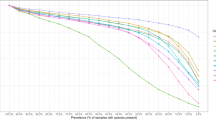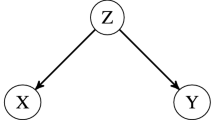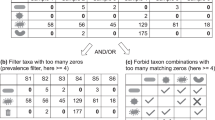Abstract
We present Transkingdom Network Analysis (TkNA), a unique causal-inference analytical framework that offers a holistic view of biological systems by integrating data from multiple cohorts and diverse omics types. TkNA helps to decipher key players and mechanisms governing host–microbiota (or any multi-omic data) interactions in specific conditions or diseases. TkNA reconstructs a network that represents a statistical model capturing the complex relationships between different omics in the biological system. It identifies robust and reproducible patterns of fold change direction and correlation sign across several cohorts to select differential features and their per-group correlations. The framework then uses causality-sensitive metrics, statistical thresholds and topological criteria to determine the final edges forming the transkingdom network. With the subsequent network’s topological features, TkNA identifies nodes controlling a given subnetwork or governing communication between kingdoms and/or subnetworks. The computational time for the millions of correlations necessary for network reconstruction in TkNA typically takes only a few minutes, varying with the study design. Unlike most other multi-omics approaches that find only associations, TkNA focuses on establishing causality while accounting for the complex structure of multi-omic data. It achieves this without requiring huge sample sizes. Moreover, the TkNA protocol is user friendly, requiring minimal installation and basic familiarity with Unix. Researchers can access the TkNA software at https://github.com/CAnBioNet/TkNA/.
Key points
-
Transkingdom Network Analysis (TkNA) is a unique analytical framework for inferring causal factors underlying host–microbiota and other multi-omic interactions, by integrating data from multiple cohorts and diverse omics types.
-
Unlike most other multi-omics approaches that find only associations, TkNA focuses on establishing causality while accounting for the complex structure of multi-omic data, which it achieves without requiring huge sample sizes.
This is a preview of subscription content, access via your institution
Access options
Access Nature and 54 other Nature Portfolio journals
Get Nature+, our best-value online-access subscription
$29.99 / 30 days
cancel any time
Subscribe to this journal
Receive 12 print issues and online access
$259.00 per year
only $21.58 per issue
Buy this article
- Purchase on Springer Link
- Instant access to full article PDF
Prices may be subject to local taxes which are calculated during checkout










Similar content being viewed by others
Data availability
Raw data used for the analysis that generated Fig. 3 and Supplementary Fig. 2 are available in the supporting primary research article, ref. 3. A graphical user interface version of TkNA is also available at https://bioinfo-abcc.ncifcrf.gov/TkNA.
Code availability
The TkNA pipeline is publicly available at https://github.com/CAnBioNet/TkNA. The code in this protocol has been peer reviewed.
References
Morgun, A. et al. Uncovering effects of antibiotics on the host and microbiota using transkingdom gene networks. Gut 64, 1732–1743 (2015).
Rodrigues, R. R. et al. Antibiotic-induced alterations in gut microbiota are associated with changes in glucose metabolism in healthy mice. Front. Microbiol. 8, 2306 (2017).
Rodrigues, R. R. et al. Transkingdom interactions between Lactobacilli and hepatic mitochondria attenuate western diet-induced diabetes. Nat. Commun. 12, 101 (2021).
Shulzhenko, N. et al. CVID enteropathy is characterized by exceeding low mucosal IgA levels and interferon-driven inflammation possibly related to the presence of a pathobiont. Clin. Immunol. 197, 139–153 (2018).
Davar, D. et al. Fecal microbiota transplant overcomes resistance to anti–PD-1 therapy in melanoma patients. Science 371, 595–602 (2021).
Lam, K. C. et al. Microbiota triggers STING-type I IFN-dependent monocyte reprogramming of the tumor microenvironment. Cell 184, 5338–5356.e21 (2021).
McCulloch, J. A. et al. Intestinal microbiota signatures of clinical response and immune-related adverse events in melanoma patients treated with anti-PD-1. Nat. Med. 28, 545–556 (2022).
Spencer, C. N. et al. Dietary fiber and probiotics influence the gut microbiome and melanoma immunotherapy response. Science 374, 1632–1640 (2021).
Lam, K. C. et al. Transkingdom network reveals bacterial players associated with cervical cancer gene expression program. PeerJ 6, e5590 (2018).
Yambartsev, A. et al. Unexpected links reflect the noise in networks. Biol. Direct 11, 1–12 (2016).
Shannon, P. et al. Cytoscape: a software environment for integrated models of biomolecular interaction networks. Genome Res. 13, 2498–2504 (2003).
Blondel, V. D., Guillaume, J.-L., Lambiotte, R. & Lefebvre, E. Fast unfolding of communities in large networks. J. Stat. Mech. 2008, P10008 (2008).
Rosvall, M., Axelsson, D. & Bergstrom, C. T. The map equation. Eur. Phys. J. Spec. Top. 178, 13–23 (2009).
Padiadpu, J. et al. Multi-omic network analysis identified betacellulin as a novel target of omega-3 fatty acid attenuation of western diet-induced nonalcoholic steatohepatitis. EMBO Mol. Med. 15, e18367 (2023).
Newman, M. E. Assortative mixing in networks. Phys. Rev. Lett. 89, 208701 (2002).
Borgatti, S. P. The Key Player Problem. Available at https://papers.ssrn.com/sol3/papers.cfm?abstract_id=1149843 (2003).
Freeman, L. C. in Social Networks: Critical Concepts in Sociology (ed. Scott, J.) 238–263 (Routledge, 2002).
Dong, X. et al. Reverse enGENEering of regulatory networks from big data: a roadmap for biologists. Bioinform. Biol. Insights 9, 61–74 (2015).
Power, J. D., Schlaggar, B. L., Lessov-Schlaggar, C. N. & Petersen, S. E. Evidence for hubs in human functional brain networks. Neuron 79, 798–813 (2013).
Li, Z. et al. Microbiota and adipocyte mitochondrial damage in type 2 diabetes are linked by Mmp12+ macrophages. J. Exp. Med. 219, e20220017 (2022).
Shulzhenko, N. et al. Crosstalk between B lymphocytes, microbiota and the intestinal epithelium governs immunity versus metabolism in the gut. Nat. Med. 17, 1585–1593 (2011).
Mine, K. L. et al. Gene network reconstruction reveals cell cycle and antiviral genes as major drivers of cervical cancer. Nat. Commun. 4, 1806 (2013).
Greer, R. L. et al. Akkermansia muciniphila mediates negative effects of IFNgamma on glucose metabolism. Nat. Commun. 7, 13329 (2016).
Kahalehili, H. M. et al. Dietary indole-3-carbinol activates AhR in the gut, alters Th17-microbe interactions, and exacerbates insulitis in NOD mice. Front. Immunol. 11, 606441 (2021).
Balduzzi, S., Rücker, G. & Schwarzer, G. How to perform a meta-analysis with R: a practical tutorial. BMJ Ment. Health 22, 153–160 (2019).
Schwarzer, G., Carpenter, J. R. & Rücker, G. Meta-analysis with R (Springer, 2015).
Sera, F., Armstrong, B., Blangiardo, M. & Gasparrini, A. An extended mixed‐effects framework for meta‐analysis. Stat. Med. 38, 5429–5444 (2019).
Rohart, F., Gautier, B., Singh, A. & Lê Cao, K.-A. mixOmics: an R package for ‘omics feature selection and multiple data integration. PLoS Comput. Biol. 13, e1005752 (2017).
Argelaguet, R. et al. MOFA+: a statistical framework for comprehensive integration of multi-modal single-cell data. Genome Biol. 21, 1–17 (2020).
Argelaguet, R. et al. Multi‐Omics Factor Analysis—a framework for unsupervised integration of multi‐omics data sets. Mol. Syst. Biol. 14, e8124 (2018).
Mo, Q. & Shen, R. iClusterPlus: integrative clustering of multiple genomic data sets. R package version 1.38.0 https://bioconductor.org/packages/iClusterPlus (2023).
Mo, Q. et al. Pattern discovery and cancer gene identification in integrated cancer genomic data. Proc. Natl Acad. Sci. USA 110, 4245–4250 (2013).
Davey Smith, G. & Hemani, G. Mendelian randomization: genetic anchors for causal inference in epidemiological studies. Hum. Mol. Genet. 23, R89–R98 (2014).
Davey Smith, G. & Ebrahim, S. in Biosocial Surveys (National Academies Press, 2008).
Yang, Q., Lin, S. L., Kwok, M. K., Leung, G. M. & Schooling, C. M. The roles of 27 genera of human gut microbiota in ischemic heart disease, type 2 diabetes mellitus, and their risk factors: a Mendelian randomization study. Am. J. Epidemiol. 187, 1916–1922 (2018).
Liu, X. et al. Mendelian randomization analyses support causal relationships between blood metabolites and the gut microbiome. Nat. Genet. 54, 52–61 (2022).
Wang, C., Hu, J., Blaser, M. J. & Li, H. Estimating and testing the microbial causal mediation effect with high-dimensional and compositional microbiome data. Bioinformatics 36, 347–355 (2020).
Cheung, M. W.-L. A guide to conducting a meta-analysis with non-independent effect sizes. Neuropsychol. Rev. 29, 387–396 (2019).
VanderWeele, T. J. Mediation analysis: a practitioner’s guide. Annu. Rev. Public Health 37, 17–32 (2016).
Baiocchi, M., Cheng, J. & Small, D. S. Instrumental variable methods for causal inference. Stat. Med. 33, 2297–2340 (2014).
Skinner, J. et al. Construct and compare gene coexpression networks with DAPfinder and DAPview. BMC Bioinforma. 12, 1–8 (2011).
Thomas, L. D., Vyshenska, D., Shulzhenko, N., Yambartsev, A. & Morgun, A. Differentially correlated genes in co-expression networks control phenotype transitions. F1000Res. 5, 2740 (2016).
Braun, R., Cope, L. & Parmigiani, G. Identifying differential correlation in gene/pathway combinations. BMC Bioinforma. 9, 1–17 (2008).
Chunikhina, E. et al. The C-SHIFT algorithm for normalizing covariances. IEEE/ACM Trans. Comput. Biol. Bioinform. 20, 720–730 (2022).
Välikangas, T., Suomi, T. & Elo, L. L. A systematic evaluation of normalization methods in quantitative label-free proteomics. Brief. Bioinform. 19, 1–11 (2018).
Zhang, Y. et al. Improvements in metabolic syndrome by xanthohumol derivatives are linked to altered gut microbiota and bile acid metabolism. Mol. Nutr. Food Res. 64, e1900789 (2020).
Padiadpu, J. et al. Early transcriptome changes associated with western diet induced NASH in Ldlr−/− mice points to activation of hepatic macrophages and an acute phase response. Front. Nutr. 10, 1147602 (2023).
Danelishvili, L. et al. Mycobacterium tuberculosis proteome response to antituberculosis compounds reveals metabolic “escape” pathways that prolong bacterial survival. Antimicrob. Agents Chemother. 61, e00430-17 (2017).
Newman, N. et al. Reducing gut microbiome-driven adipose tissue inflammation alleviates metabolic syndrome. Microbiome 11, 208 (2023).
Bader, G. D. & Hogue, C. W. An automated method for finding molecular complexes in large protein interaction networks. BMC Bioinforma. 4, 1–27 (2003).
Wang, J. et al. ClusterViz: a cytoscape APP for cluster analysis of biological network. IEEE/ACM Trans. Comput. Biol. Bioinform. 12, 815–822 (2014).
Newman, M. Networks (Oxford University Press, 2018).
Zhao, Y. et al. TPM, FPKM, or normalized counts? A comparative study of quantification measures for the analysis of RNA-seq data from the NCI patient-derived models repository. J. Transl. Med. 19, 1–15 (2021).
Mortazavi, A., Williams, B. A., McCue, K., Schaeffer, L. & Wold, B. Mapping and quantifying mammalian transcriptomes by RNA-Seq. Nat. Methods 5, 621–628 (2008).
Trapnell, C. et al. Transcript assembly and abundance estimation from RNA-Seq reveals thousands of new transcripts and switching among isoforms. Nat. Biotechnol. 28, 511–515 (2010).
Bolstad, B. M., Irizarry, R. A., Åstrand, M. & Speed, T. P. A comparison of normalization methods for high density oligonucleotide array data based on variance and bias. Bioinformatics 19, 185–193 (2003).
Yang, Y. H., Dudoit, S., Luu, P. & Speed, T. P. Normalization for cDNA microarry data. In Microarrays: Optical Technologies and Informatics Vol. 4266, 141–152 (SPIE, 2001).
Robinson, M. D. & Oshlack, A. A scaling normalization method for differential expression analysis of RNA-seq data. Genome Biol. 11, 1–9 (2010).
Love, M. I., Huber, W. & Anders, S. Moderated estimation of fold change and dispersion for RNA-seq data with DESeq2. Genome Biol. 15, 1–21 (2014).
Gautier, L., Cope, L., Bolstad, B. M. & Irizarry, R. A. affy—analysis of Affymetrix GeneChip data at the probe level. Bioinformatics 20, 307–315 (2004).
Robinson, M. D., McCarthy, D. J. & Smyth, G. K. edgeR: a Bioconductor package for differential expression analysis of digital gene expression data. Bioinformatics 26, 139–140 (2010).
Sanders, H. L. Marine benthic diversity: a comparative study. Am. Nat. 102, 243–282 (1968).
Joseph, N., Paulson, C., Corrada Bravo, H. & Pop, M. Robust methods for differential abundance analysis in marker gene surveys. Nat. Methods 10, 1200–1202 (2013).
Bolyen, E. et al. Reproducible, interactive, scalable and extensible microbiome data science using QIIME 2. Nat. Biotechnol. 37, 852–857 (2019).
Paulson, J. N., Pop, M. & Bravo, H. C. metagenomeSeq: statistical analysis for sparse high-throughput sequencing. Bioconductor Package 1 https://www.cbcb.umd.edu/software/metagenomeSeq (2013).
Bijlsma, S. et al. Large-scale human metabolomics studies: a strategy for data (pre-) processing and validation. Anal. Chem. 78, 567–574 (2006).
Sysi-Aho, M., Katajamaa, M., Yetukuri, L. & Orešič, M. Normalization method for metabolomics data using optimal selection of multiple internal standards. BMC Bioinforma. 8, 1–17 (2007).
Warrack, B. M. et al. Normalization strategies for metabonomic analysis of urine samples. J. Chromatogr. B Anal. Technol. Biomed. Life Sci. 877, 547–552 (2009).
Saccenti, E. Correlation patterns in experimental data are affected by normalization procedures: consequences for data analysis and network inference. J. Proteome Res. 16, 619–634 (2017).
Dieterle, F., Ross, A., Schlotterbeck, G. & Senn, H. Probabilistic quotient normalization as robust method to account for dilution of complex biological mixtures. Application in 1H NMR metabonomics. Anal. Chem. 78, 4281–4290 (2006).
Wulff, J. E. & Mitchell, M. W. A comparison of various normalization methods for LC/MS metabolomics data. Adv. Biosci. Biotechnol. 9, 339 (2018).
Karpievitch, Y. V. et al. Normalization of peak intensities in bottom-up MS-based proteomics using singular value decomposition. Bioinformatics 25, 2573–2580 (2009).
Ernest, B., Gooding, J. R., Campagna, S. R., Saxton, A. M. & Voy, B. H. MetabR: an R script for linear model analysis of quantitative metabolomic data. BMC Res. notes 5, 1–10 (2012).
Karpievitch, Y., Stuart, T. & Mohamed, S. ProteoMM: multi-dataset model-based differential expression proteomics analysis platform. R package version 1 https://bioconductor.org/packages/ProteoMM (2023).
Röst, H. L. et al. OpenMS: a flexible open-source software platform for mass spectrometry data analysis. Nat. Methods 13, 741–748 (2016).
Röst, H. L., Schmitt, U., Aebersold, R. & Malmström, L. pyOpenMS: a Python‐based interface to the OpenMS mass‐spectrometry algorithm library. Proteomics 14, 74–77 (2014).
Callister, S. J. et al. Normalization approaches for removing systematic biases associated with mass spectrometry and label-free proteomics. J. Proteome Res. 5, 277–286 (2006).
Huber, W., Von Heydebreck, A., Sültmann, H., Poustka, A. & Vingron, M. Variance stabilization applied to microarray data calibration and to the quantification of differential expression. Bioinformatics 18, S96–S104 (2002).
Graw, S. et al. proteiNorm–a user-friendly tool for normalization and analysis of TMT and label-free protein quantification. ACS Omega 5, 25625–25633 (2020).
Zhou, Y. et al. Metascape provides a biologist-oriented resource for the analysis of systems-level datasets. Nat. Commun. 10, 1523 (2019).
Lynn, D. J. et al. InnateDB: facilitating systems‐level analyses of the mammalian innate immune response. Mol. Syst. Biol. 4, 218 (2008).
Subramanian, A. et al. Gene set enrichment analysis: a knowledge-based approach for interpreting genome-wide expression profiles. Proc. Natl Acad. Sci. 102, 15545–15550 (2005).
Gillespie, M. et al. The reactome pathway knowledgebase 2022. Nucleic Acids Res. 50, D687–D692 (2022).
Szklarczyk, D. et al. The STRING database in 2021: customizable protein–protein networks, and functional characterization of user-uploaded gene/measurement sets. Nucleic Acids Res. 49, D605–D612 (2021).
Dhariwal, A. et al. MicrobiomeAnalyst: a web-based tool for comprehensive statistical, visual and meta-analysis of microbiome data. Nucleic Acids Res. 45, W180–W188 (2017).
Langille, M. G. et al. Predictive functional profiling of microbial communities using 16S rRNA marker gene sequences. Nat. Biotechnol. 31, 814–821 (2013).
Pang, Z. et al. MetaboAnalyst 5.0: narrowing the gap between raw spectra and functional insights. Nucleic Acids Res. 49, W388–W396 (2021).
Kanehisa, M. & Goto, S. KEGG: Kyoto Encyclopedia of Genes and Genomes. Nucleic Acids Res. 28, 27–30 (2000).
Acknowledgements
The funding that supports this work is AI157369 (to A.M.), DK103761 (to N.S.), DK107603 (to A.M.) and BC011153 (to G.T.), NCI/NIH (Contract No. 75N91019D00024 (to J.S. and J.W.)). S.S.P. and M.S.M. were supported by summer fellowships from the College of Pharmacy at Oregon State University. We thank Isaiah Shriver for aiding in testing the code.
Author information
Authors and Affiliations
Contributions
N.S. and A.M. conceived the original version of TkNA. N.K.N., M.S.M., R.R.R., A.K.D., N.S., G.T., K.B. and A.M. designed the current TkNA framework. N.K.N. and M.S.M. implemented the coding part of the TkNA workflow. R.R.R. and J.P. prepared parts of the TkNA workflow that require additional software. A.M.B., J.W.P. and S.S.P. performed the validation. N.K.N., R.R.R. and A.M.B. prepared the simulated data. R.R.R. prepared the experimental data. N.K.N. and A.M.B. prepared the figures. J.S. and J.W. built the web tool version of TkNA. N.K.N., M.S.M., R.R.R., J.P. and K.B. wrote the paper. A.M.B., J.W.P., S.S.P., J.P., A.K.D., N.S., G.T., K.B. and A.M. edited the paper. N.S., G.T., K.B. and A.M. supervised various aspects of this study.
Corresponding authors
Ethics declarations
Competing interests
The authors declare no competing interests.
Peer review
Peer review information
Nature Protocols thanks Nikita Agarwal, Torgeir Hvidsten and Jayadev Joshi for their contribution to the peer review process.
Additional information
Publisher’s note Springer Nature remains neutral with regard to jurisdictional claims in published maps and institutional affiliations.
Related links
Key references using this protocol
Morgun, A. et al. Gut 64, 1732–1743 (2015): https://doi.org/10.1136/gutjnl-2014-308820
Rodrigues, R. R. et al. Nat. Commun. 12, 101 (2021): https://doi.org/10.1038/s41467-020-20313-x
Li, Z. et al. J. Exp. Med. 219, e20220017 (2022): https://doi.org/10.1084/jem.20220017
Supplementary information
Supplementary Information
Supplementary Figs. 1 and 2
Rights and permissions
Springer Nature or its licensor (e.g. a society or other partner) holds exclusive rights to this article under a publishing agreement with the author(s) or other rightsholder(s); author self-archiving of the accepted manuscript version of this article is solely governed by the terms of such publishing agreement and applicable law.
About this article
Cite this article
Newman, N.K., Macovsky, M.S., Rodrigues, R.R. et al. Transkingdom Network Analysis (TkNA): a systems framework for inferring causal factors underlying host–microbiota and other multi-omic interactions. Nat Protoc (2024). https://doi.org/10.1038/s41596-024-00960-w
Received:
Accepted:
Published:
DOI: https://doi.org/10.1038/s41596-024-00960-w
Comments
By submitting a comment you agree to abide by our Terms and Community Guidelines. If you find something abusive or that does not comply with our terms or guidelines please flag it as inappropriate.



